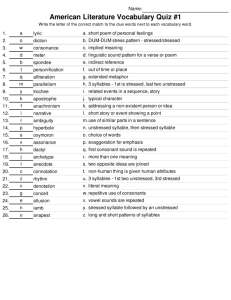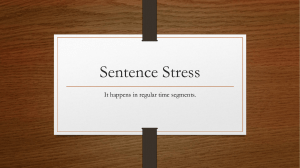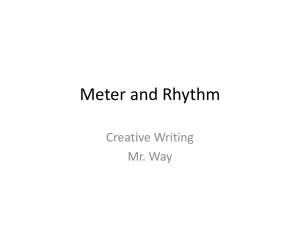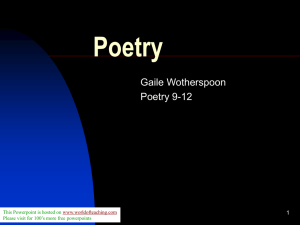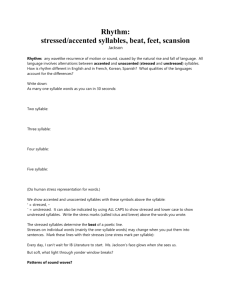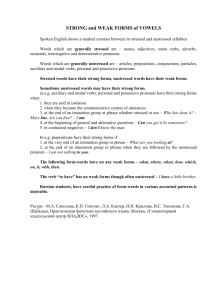Examples of Meter
advertisement
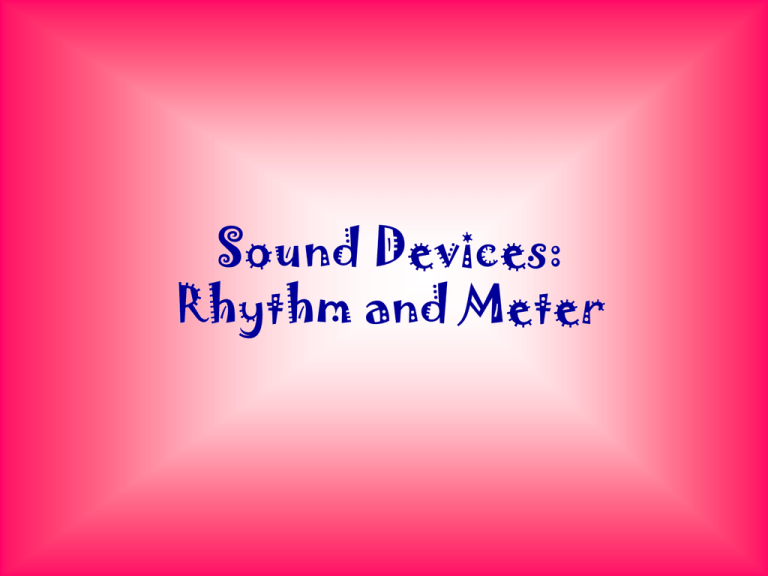
Sound Devices: Rhythm and Meter Syllables • A syllable is a beat. When a word has one beat, we say it has one syllable; when a word has two beats, we say it has two syllables. Practice: A. How many syllables are in the following examples? 1. Car 1 2. Blue Car 2 3. Yellow Car 3 4. Her orange car is fast. 6 B. How many syllables are in your name? Stressed and Unstressed • People automatically adjust their words so that some syllables are spoken with emphasis and some are spoken softer. Our speech naturally fades in and out and moves up and down as we speak. • When we emphasize a syllable or make it louder we are stressing that syllable. (STRESSED) • When we soften a syllable and allow it to fade into the background we are not stressing the syllable. (UNSTRESSED) Stressed and Unstressed • Stressed syllables are marked with an accent mark ( a slanted line above the syllable kind of like a sideways exclamation point). • Unstressed syllables are marked with a shallow and long “U”. U • Example: Purple U U Excellent Stressed and Unstressed • Sometimes it is easier to figure out what is stressed and unstressed if we raise our hands on the stressed parts and lower hands on unstressed parts. • Practice by marking each syllable as stressed or unstressed. 1. apricot 2. piano 3. What a lovely day! Patterns • Patterns are things that are repeated and organized in a predictable form. • Example: yellow green blue yellow green blue yellow green blue • Practice: Find the pattern in each example and draw a line each time the pattern ends and begins again. 1. cat dog cat dog cat dog 2. A D F A D F A D F A D F A D F Rhythm and Meter • The process of analyzing a poem’s pattern of unstressed and stressed syllables in each line is called SCANSION. • If a poem’s rhythm is organized into a reoccurring pattern, then this is called METER; • Therefore, scansion is the act of figuring out a poem’s meter or repeated pattern of beats and rhythm. Rhythm and Meter • Meter is measured in feet. (Not the same as a ruler or the metric system) • A foot is a combination of two or three syllables that are stressed and unstressed. • The number of syllables and the location of the stress is what determines what type of foot the meter is classified as. Rhythm and Meter • It is important to realize that SCANSION is to an extent a matter of interpretation because the rhythm of a poem can vary from speaker to speaker and situation to situation. • Think: If the same poem was read at both a funeral and a pep rally, how might the delivery of that poem change? Rhythm and Meter • The four most common feet in English Poetry: 1. IAMB (adj. IAMBIC) • unstressed-stressed (ta-DA) • Example- NEW YORK 2. TROCHEE (adj. TROCHAIC) • stressed-unstressed (TA-da) • Example- DELHI Rhythm and Meter • Common feet (cont.): 3. ANAPEST (adj. ANAPESTIC) • unstressed-unstressed-stressed (la-la-LA) • Example- TENNESSEE 4. DACTYL (adj. DACTYLIC) • stressed-unstressed-unstressed (LA-la-la) • Example- DELAWARE Number of feet per line • NUMBER OF FEET PER LINE: – 1--MONOMETER – 2--DIMETER – 3--TRIMETER – 4--TETRAMETER – 5--PENTAMETER – 6--HEXAMETER – 7- HEPTAMETER – 8- OCTAMETER Scansion • Scanned lines are labeled in two parts: – Part 1 is the type of foot or the rhythm of stressed and unstressed syllables (iamb, trochee, anapest, and dactyl) – Part 2 is the number of feet (see part 1) in the line (monometer, dimeter, trimeter, tetrameter, etc). • Practice- label each of the following examples: 1. unstressed, stressed, unstressed, stressed Iambic dimeter 2. Stressed, unstressed, unstressed, stressed, unstressed, unstressed, stressed, unstressed, unstressed, stressed, unstressed, unstressed Scansion Practice • Mark each line with the appropriate unstressed and stressed syllables (accent mark or U), draw a line separating each foot in the pattern, and label each example. 1. un, un , st, un, un , st, un, un , st, un, un , st, un, un , st, un, un , st, Anapestic Hexameter 2. st, un, st, un, st, un, st, un, st, un, st, un, st, un, Trochaic Heptameter 3. un, st Iambic monometer Examples of Meter • “They cannot know, they cannot care” / - / / - / Answer: iambic tetrameter Examples of Meter • “Once upon a midnight dreary, while I / - / - / - / - / pondered weak and weary” / / / Answer: trochaic octameter Examples of Meter • “Love again, song again, nest again, young again.” / - / - / - / - - Answer: dactylic tetrameter Examples of Meter • “With the sheep in the fold and the - / - - / - cows in their stalls” / - / Answer: anapestic tetrameter Rhythm and Meter • From the Renaissance to the rise of the FREE VERSE in the 20th century, IAMBIC meter was the most common in English poetry, considered by many to be the meter closest to everyday speech. • Shakespeare mainly wrote in iambic pentameter. • Blank verse is written in unrhymed, iambic pentameter. Any Questions?
